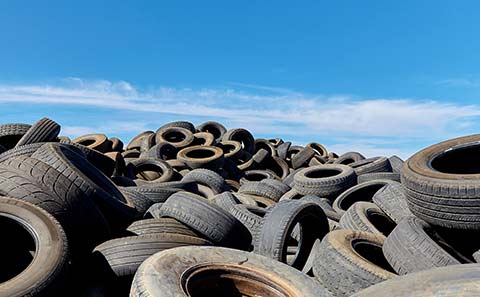UTQG ratings are a crucial part of tire manufacturing. The tread wear of different tires is not equal. While there are multiple factors that affect tread wear, the average tire mileage varies between models.
This is where the UTQG rating comes into play. This rating allows drivers to select which tires would work better with their vehicles. But, there is more to it.
So, what is UTQG on tires and why is it important?
UTQG: Traction, Temperature, and Treadwear Rating on the Tire Sidewall
The tire UTQG ratings, also known as Unique Tire Quality Grade, are located on the tire’s sidewall. This rating includes the treadwear number, temperature ratings, and traction grades. While not all tires are marked with UTQG ratings, you will find this rating on passenger car and SUV tires without issues.
Each section of the UTQG tire ratings has a specific meaning. Let’s take a closer look at them.
The Tire Treadwear Rating
Tire tread wear is measured by the treadwear grades of the UTQG. This portrays the tire’s estimated service life. For example, 200 treadwear tires will have about 20,000 miles on them. However, this estimate is not set in stone and it will vary due to external factors.
Keep in mind the following – tires’ tread wear ratings are tested in controlled environments, on a government-regulated test course. Outside conditions, driving habits, and even road hazards can shorten or lengthen the actual tread life.
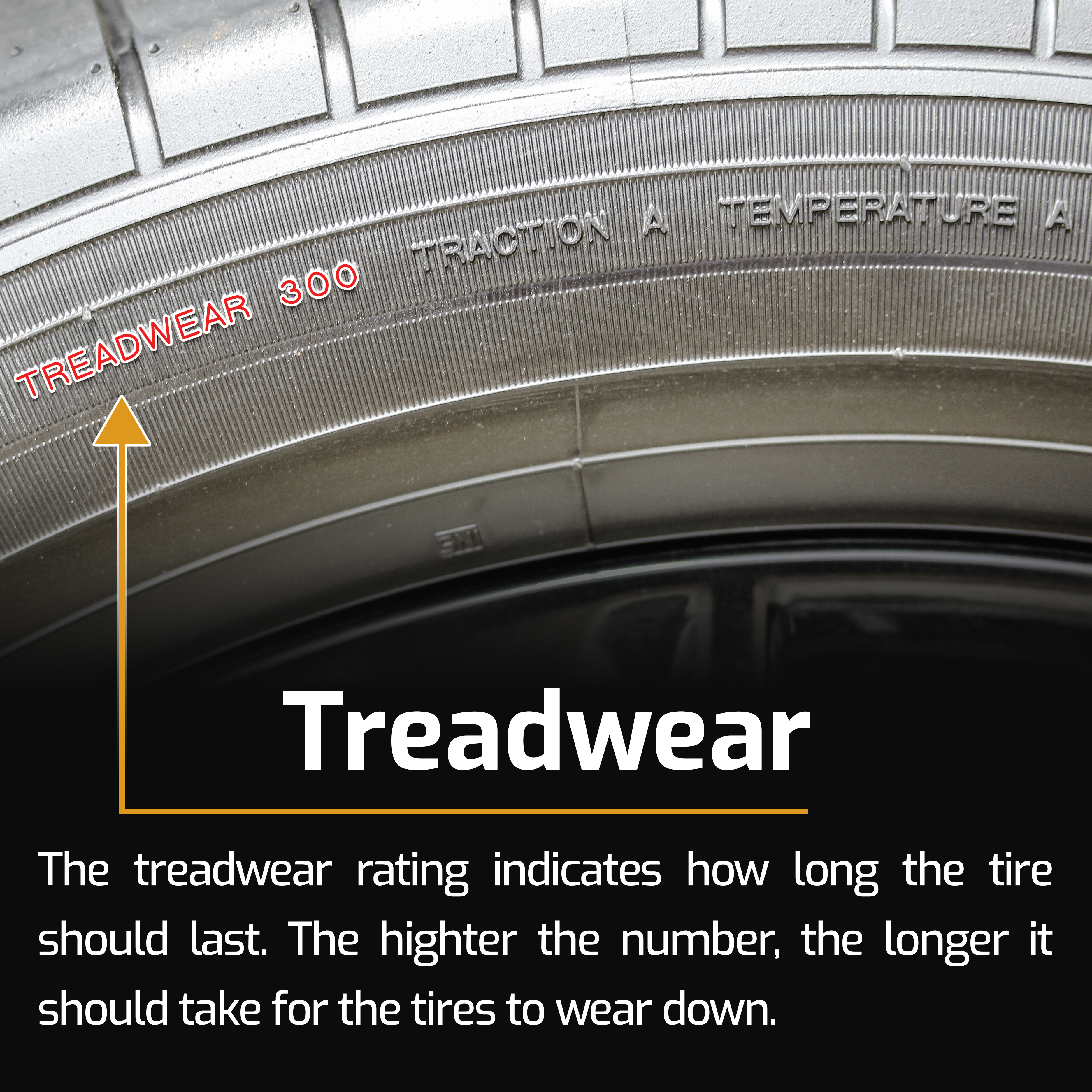
How do Treadwear Grades Relate to Mileage?
Unfortunately, no one will be able to tell you specifically how long a tire or tire set will last. External factors affecting the tires and the vehicle can significantly shorten any estimation.
But, what exactly are these factors that can throw the uniform tire quality grade rating out the window?
Tire mileage depends on the following factors:
- Tread Design – The tire tread design and compound blend alter the tread life of the tire, as different tread patterns react in versatile manners
- Driving Habits – Quick accelerations and harsh braking can significantly shorten a tire’s usability by increasing the possibility of premature and uneven wear
- Weather Conditions – Extreme weather conditions, both heat and cold, can accelerate tread wear compared to tires being used in moderate climates
- Road Quality – Various road surfaces and road hazards can fatally damage the tire and its integrity, reducing its service life
- Tire Maintenance – Regular tire maintenance is crucial to ensure a long tread life, including checking the tire pressure, alignment, rotation, and balancing
All of these above-mentioned factors can greatly shorten a tire’s usability. Once tread wear reaches the tire tread wear indicator located in the grooves, the tires should not be used anymore.
What Counts as Good Treadwear Rating?
Unfortunately, there is no straightforward answer to the tire grading system. This is because the UTQG rating chart for tires has different meanings for versatile tires, mainly because of their tread types.
When trying to determine a tire tread life expectancy chart based on the UTQG rating, we will get different answers for distinct tire categories. For example, a good tire wear rating for a high performance tire is lower than one for a regular all season tire. This is due to high performance tires are not intended to last as long, as their primary focus is on high speed durability.
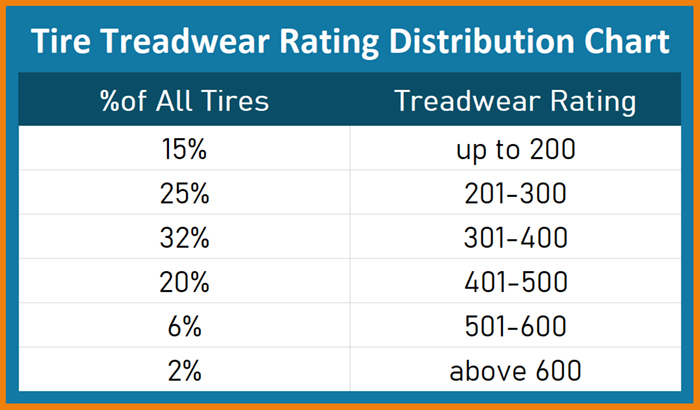
The difference between two similar UTQG treadwear grade ratings can be minimal. It all boils down to whether the specific tire model has the size you need or not. But, with bigger jumps between numbers (250 compared to 500 for example), the treadwear grade creates significant distinctness.
So, why would you settle for lower UTQG treadwear grades?
Manufacturers design some tires, along with their tread patterns, for specific applications. In those instances, the UTQG treadwear grade takes a back seat.
Technically, winter tires’ wear rating is lower, but they provide traction on icy and snow-covered roads. Even if some all season models are high-tread tires, you don’t want to try your luck with them in winter conditions.
Where to Find Your Tire Treadwear Rating?
You can find the treadwear, traction, and temperature grades on the tire’s sidewall. It is located near the tread shoulder and the maximum section width.
Sometimes brands print the UTQG grades onto the label located on new tires. However, this is not a universal practice.
UTQG: Traction Rating on Tires
The second part of the UTQG is the traction grades. These are symbolized with letters, ranging from AA, A, B, and C. Tire temperature AA is the best available on the market, tire temp A is the second best, and so on.
The traction grade helps determine a tire’s controllability and braking capability. However, like with the tire wear mark, manufacturers also test the traction grade under controlled conditions.
This part of the UTQG helps the tire rating guide conclude a specific tire’s straight traction when braking. Yet, it does not take into account turning traction during maneuvering.
Check out this tire traction rating chart:
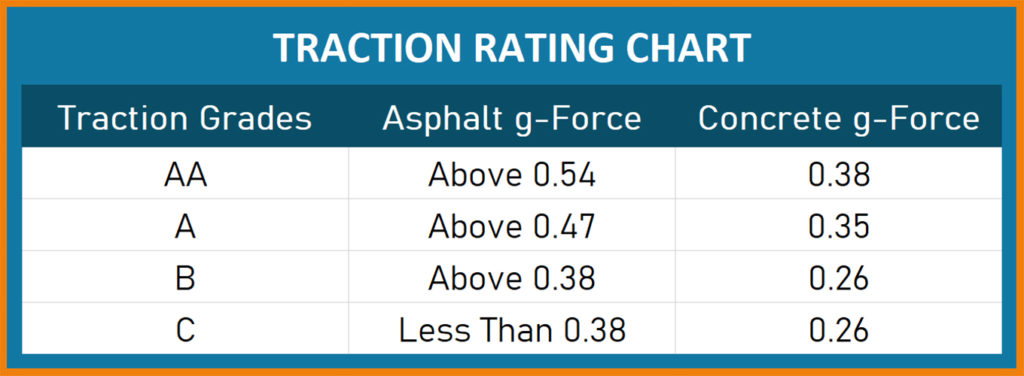
UTQG: Tire Temperature Rating
The temperature grade determines the tire’s heat durability. In other words, how well each tire can prevent heat build-up and distribute heat evenly along their tread area.
The tire industry uses letters to mark the temperature grade on the tire sidewall. A, B, and C represent how well a tire can handle heat accumulation, which also determines its speed capacity. They test temperature ratings in controlled environments on an indoor testing wheel.
Why Is the Tire Temperature Rating Important?
High temperatures can shorten the tread life by causing the rubber to wear away more quickly. Additionally, it can also lead to tire failure. Each passenger tire must have at least a tire temperature rating of C, which is the lowest the Federal Motor Safety Standards allows for exactly this reason. Tire temperature A and B offer better high speed performance compared to their C counterparts.
It is important to note that temperature testing of the tires occurs with proper inflation levels and no overloading. If tires are under or overinflated, carry excess loads, and are driven at higher speeds than intended, heat accumulation and tire failure are more prominent.
Check out this tire temperature rating chart for more information:
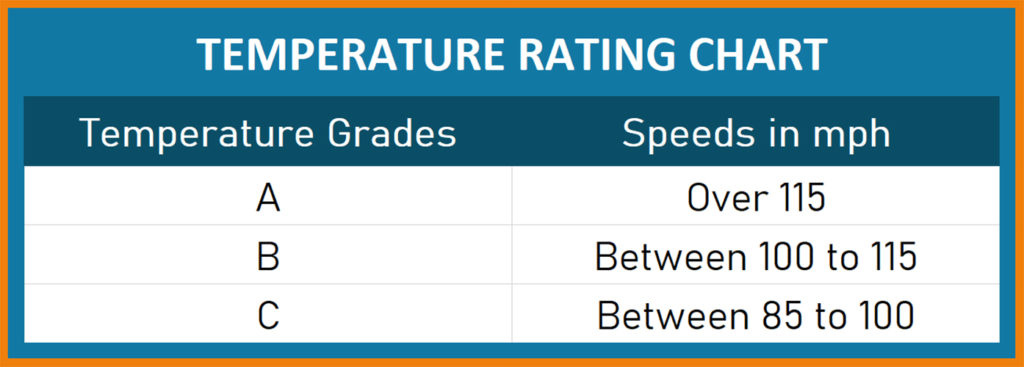
Frequently Asked Questions
What’s a Good Tire Tread Depth?
Brands manufacture passenger tires with a 10-11/32″ starting tread. However, a good tire tread depth to still use on your vehicle would be about 6/32″ or deeper as traction varies with your tire condition. The 6/32″ worn tire tread still provides adequate traction in versatile weather and surface applications.
What does UTQG Mean on Tires?
UTQG stands for Uniform Tire Quality Grade. This is a rating system tire brands use to mark their tires for treadwear, traction, and temperature. UTQG grades categorize tires based on their tread life, temperature, and traction durability.
What is a Good Treadwear Rating?
Most passenger car tires feature treadwear grades between 300 and 600. However, the highest UTQG rating is 860 for a Hankook model. Still, tires with 500 treadwear are already good. Yet, this greatly depends on what type of tire you need, as high performance tires have lower ratings than touring ones.
What is Treadwear Rating?
The tire treadwear rating, also known as UTQG tread wear rating, is a number located on the tire sidewall. It represents the estimated tread life of the tire. The higher the UTQG tire rating the better the tread life of a certain tire model will be.
